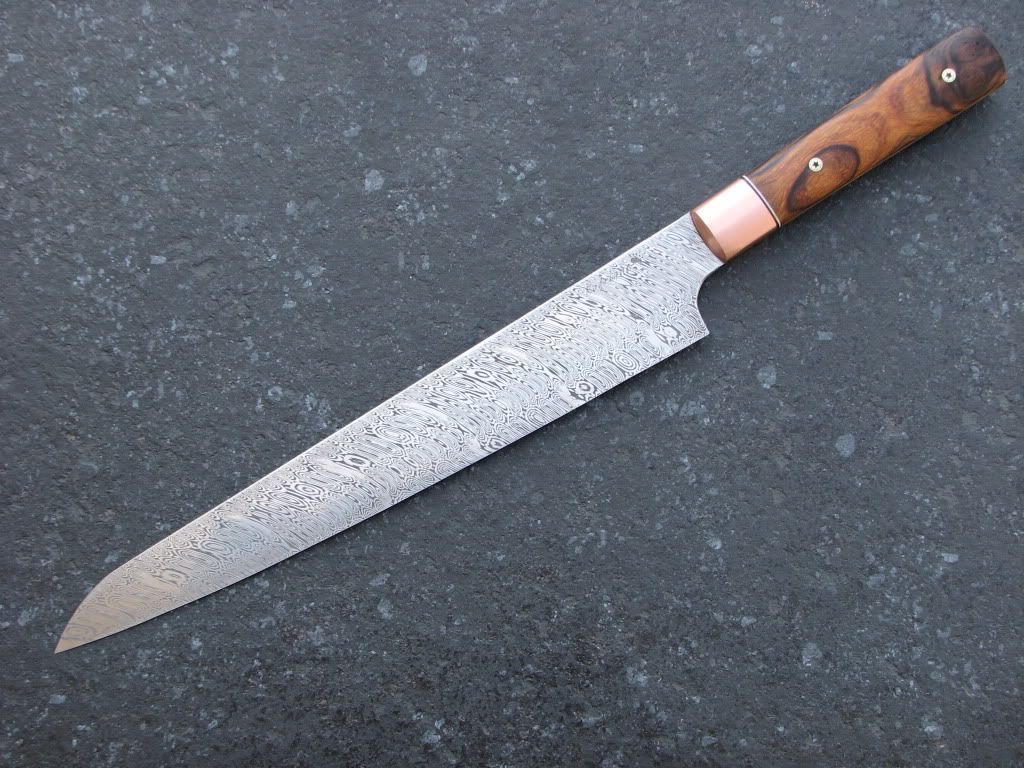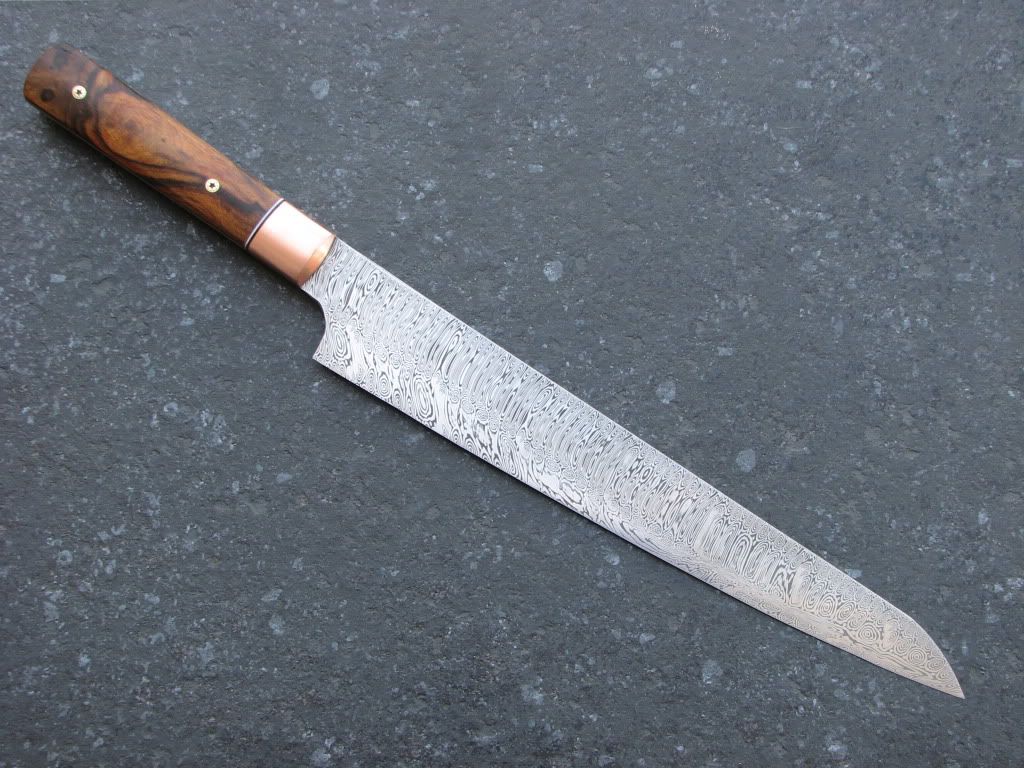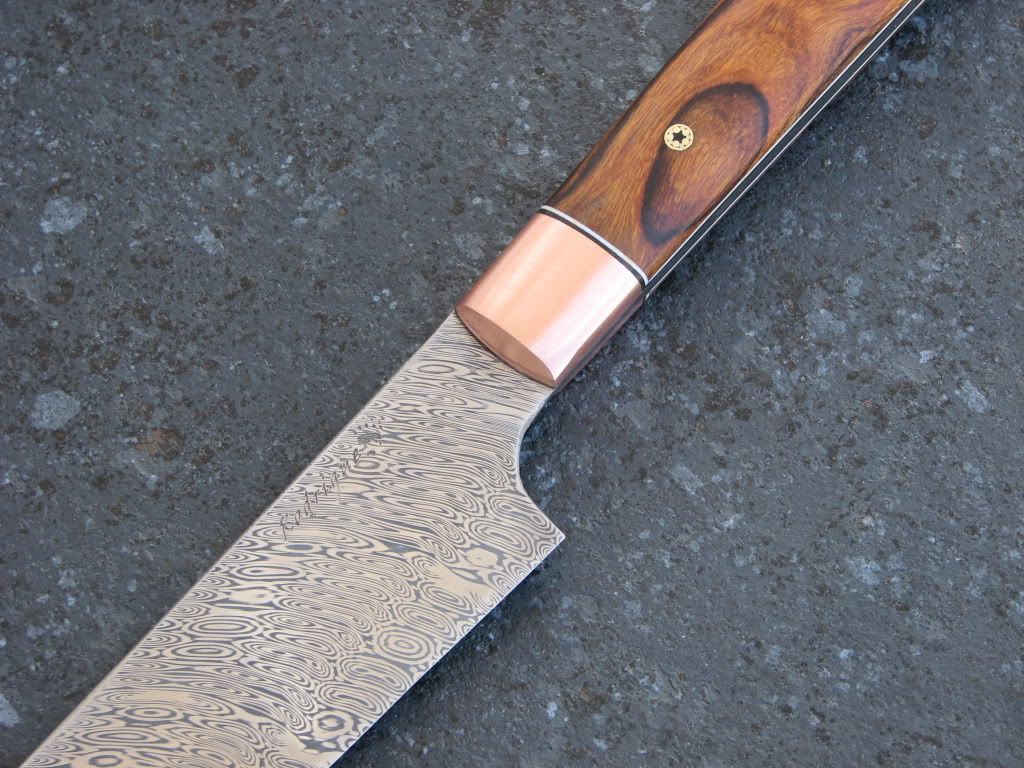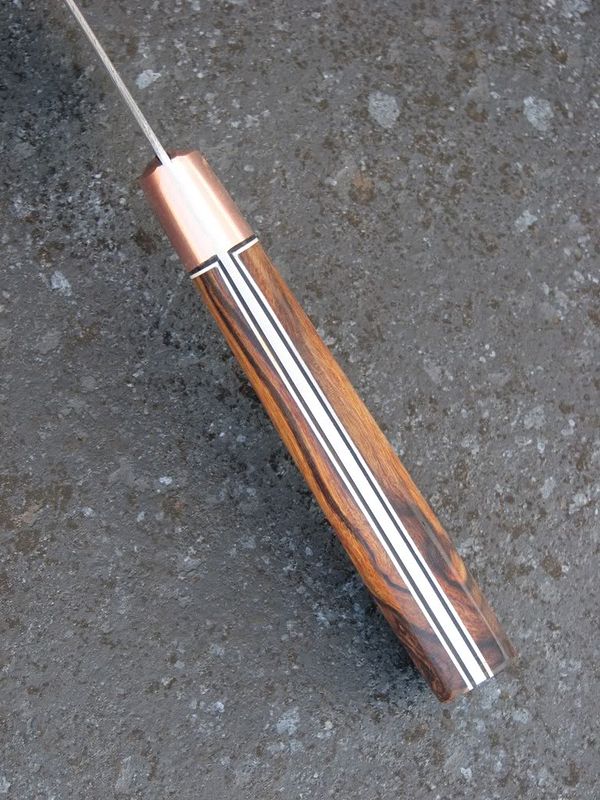RobinW
Senior Member
OK, So here is my review.
Bear in mind that I am only a home cook and as such I have waited as long as I can to write this to maximize my use of the knife before I make statements. My camera is with my family in Europe at the moment so I will need to rely on others to provide pictures. I have tried to stay out of the review thread for the last weeks so that I would be somewhat “untainted” by other reviewers opinions, some things may therefore be repetition.
First some stats:
Weight: 278 grams
Edge length:245 mm
Total length: 385 mm
Height at heel: 53 mm
Height at midpoint: 48mm
Spine thickness at heel:2.3 mm
Spine at midpoint: 2.1 mm
Spine 10mm behind tip: 0.8 mm
Balance point is right in front of the bolster
Handle: Some very nice woodwork went into this. Everything came together nicely and I imagine it is very hard to pick a spacer colour for a wood with such large colour differences. The space is white, which I think is as good a choice as any. The mosaic pins are gorgeous and I’m a bit surprised that I liked them since I prefer plain pins when the wood is multicoloured.
As for the shape I am not that big a fan of it. The handle is too tall and too narrow for me. It feels bigger than it needs to be and it’s too long. The only way to use all of it is to grip the knife like a hammer. The bolster is a bit "sharpish" in the front edge making it not so nice to grip using pinch. Given that I very rarely use western handles, I am not sure that one should place too much emphasis on my feelings on this topic. I’m sure it would be perfect for others.
The blade: This is my first experience with Damasteel (although it is from my home country, it is not widely used there either) and all I can say is WOW! It is very beautiful! Do not expect a traditional damascus pattern, but for someone who wants something unique this is absolutely a candidate. If Pierre was not halfway done with my own gyuto I would have changed my mind.
The knife came to me somewhat dull so I sharpened it going through 2k/5k/Kitayama 8k/JKS 10k but no stropping. You can feel it is stainless on the stones, but better than the average stainless (I mainly use carbon). The edge it takes is great (and it was fast getting there) and I did not have any problems deburring it. The shiny edge contrasts the blade sides very nicely. A negative is that the etching almost has Pierres logo hidden, you really have to look for it. I assume this could be remedied by making the logo deeper.
Even being a carbon fan, I would definitively put Damasteel on my shortlist of nice steels to have and Pierre has done a very nice job hammering it!
The profile is fairly tall, with a long flat area in the back half, I like this a lot, board contact is king. It came to me slightly oversharpened in the heel section so a flattening job might be in order. It was very slight though and not something that bothered me in use.
The tip is a tad high for my taste, I like a flatter profile in my gyutos, but I think for someone who sometimes rock it may be ideal.
The spine is almost flat for 200 mm making it very good for “board management”.
In use: This is a sturdy knife but it cuts very nicely. I actually thought it was a 270 in use, mainly because my only 270 reference is a Takeda 275 mm gyuto and that actually is quite a lot lighter. Things stick to the blade sides, pretty much as for every other polished knife I have, not worse but not better either. The tip is thin enough to not wedge most foods although most of the knife would benefit from being thinner behind the edge. As I did not want to ruin the etch job (duh!) I did not do this. I would be surprised if the steel could not take a thinning, I saw absolutely no tendencies for chipping. After a few days of use the weight of the knife stopped surprising me and it felt very natural to use it. With a good edge it goes through food easily just by the weight alone. I;d still prefer the balance point a bit further forward though..
Lastly I applaude Pierre (and the other makers) for taking the effort and doing a passaround. I believe that it is an excellent way of learning and I think making kitchen knives are more complicated than most makers believes (hopes?). Getting it absolutely right will take lots of practicing, thinking and feedback. I think this is a good way to go.
Bottom line: Pierre is a very talented knifemaker and although this specific knife is not perfect for me I am going to be very sad seeing it go tomorrow. F&F is excellent as to be expected from a full custom maker. The steel is great and the esthetics is brilliant.
Bear in mind that I am only a home cook and as such I have waited as long as I can to write this to maximize my use of the knife before I make statements. My camera is with my family in Europe at the moment so I will need to rely on others to provide pictures. I have tried to stay out of the review thread for the last weeks so that I would be somewhat “untainted” by other reviewers opinions, some things may therefore be repetition.
First some stats:
Weight: 278 grams
Edge length:245 mm
Total length: 385 mm
Height at heel: 53 mm
Height at midpoint: 48mm
Spine thickness at heel:2.3 mm
Spine at midpoint: 2.1 mm
Spine 10mm behind tip: 0.8 mm
Balance point is right in front of the bolster
Handle: Some very nice woodwork went into this. Everything came together nicely and I imagine it is very hard to pick a spacer colour for a wood with such large colour differences. The space is white, which I think is as good a choice as any. The mosaic pins are gorgeous and I’m a bit surprised that I liked them since I prefer plain pins when the wood is multicoloured.
As for the shape I am not that big a fan of it. The handle is too tall and too narrow for me. It feels bigger than it needs to be and it’s too long. The only way to use all of it is to grip the knife like a hammer. The bolster is a bit "sharpish" in the front edge making it not so nice to grip using pinch. Given that I very rarely use western handles, I am not sure that one should place too much emphasis on my feelings on this topic. I’m sure it would be perfect for others.
The blade: This is my first experience with Damasteel (although it is from my home country, it is not widely used there either) and all I can say is WOW! It is very beautiful! Do not expect a traditional damascus pattern, but for someone who wants something unique this is absolutely a candidate. If Pierre was not halfway done with my own gyuto I would have changed my mind.
The knife came to me somewhat dull so I sharpened it going through 2k/5k/Kitayama 8k/JKS 10k but no stropping. You can feel it is stainless on the stones, but better than the average stainless (I mainly use carbon). The edge it takes is great (and it was fast getting there) and I did not have any problems deburring it. The shiny edge contrasts the blade sides very nicely. A negative is that the etching almost has Pierres logo hidden, you really have to look for it. I assume this could be remedied by making the logo deeper.
Even being a carbon fan, I would definitively put Damasteel on my shortlist of nice steels to have and Pierre has done a very nice job hammering it!
The profile is fairly tall, with a long flat area in the back half, I like this a lot, board contact is king. It came to me slightly oversharpened in the heel section so a flattening job might be in order. It was very slight though and not something that bothered me in use.
The tip is a tad high for my taste, I like a flatter profile in my gyutos, but I think for someone who sometimes rock it may be ideal.
The spine is almost flat for 200 mm making it very good for “board management”.
In use: This is a sturdy knife but it cuts very nicely. I actually thought it was a 270 in use, mainly because my only 270 reference is a Takeda 275 mm gyuto and that actually is quite a lot lighter. Things stick to the blade sides, pretty much as for every other polished knife I have, not worse but not better either. The tip is thin enough to not wedge most foods although most of the knife would benefit from being thinner behind the edge. As I did not want to ruin the etch job (duh!) I did not do this. I would be surprised if the steel could not take a thinning, I saw absolutely no tendencies for chipping. After a few days of use the weight of the knife stopped surprising me and it felt very natural to use it. With a good edge it goes through food easily just by the weight alone. I;d still prefer the balance point a bit further forward though..
Lastly I applaude Pierre (and the other makers) for taking the effort and doing a passaround. I believe that it is an excellent way of learning and I think making kitchen knives are more complicated than most makers believes (hopes?). Getting it absolutely right will take lots of practicing, thinking and feedback. I think this is a good way to go.
Bottom line: Pierre is a very talented knifemaker and although this specific knife is not perfect for me I am going to be very sad seeing it go tomorrow. F&F is excellent as to be expected from a full custom maker. The steel is great and the esthetics is brilliant.








